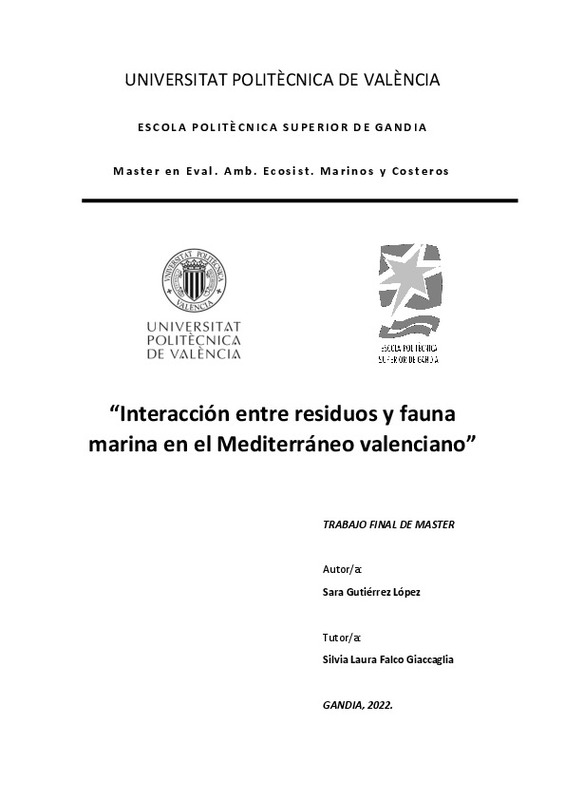JavaScript is disabled for your browser. Some features of this site may not work without it.
Buscar en RiuNet
Listar
Mi cuenta
Estadísticas
Ayuda RiuNet
Admin. UPV
Interacción entre residuos y fauna marina en el Mediterráneo valenciano
Mostrar el registro sencillo del ítem
Ficheros en el ítem
| dc.contributor.advisor | Falco Giaccaglia, Silvia Laura
|
es_ES |
| dc.contributor.author | Gutiérrez López, Sara
|
es_ES |
| dc.coverage.spatial | east=0; north=39.5; name=Espanya | es_ES |
| dc.date.accessioned | 2022-03-16T13:18:47Z | |
| dc.date.available | 2022-03-16T13:18:47Z | |
| dc.date.created | 2022-02-28 | |
| dc.date.issued | 2022-03-16 | es_ES |
| dc.identifier.uri | http://hdl.handle.net/10251/181445 | |
| dc.description.abstract | [ES] La presencia de macro y microplásticos en el medio marino ejerce un papel modificante en el ecosistema. El presente estudio tiene como objetivo analizar la interacción existente entre los residuos marinos que se encuentran en el Golfo de Valencia y la fauna que aquí habita. Para ello, se observaron los residuos recogidos del fondo marino en busca de bioincrustaciones, y se escogieron 3 especies de la zona con diferencias en dieta y morfología bucal, para analizar la ingesta de microplásticos y su posible relación con la densidad de plásticos hallados en sedimentos. De los residuos con bioincrustaciones recogidos durante este proyecto, el 96,3% eran plástico. Las bioincrustaciones más frecuentes fueron los antozoos (40,7 %), seguidos por los briozoos (29,7 %). Los resultados muestran ingestión de micro plásticos en el 44 % de los peces analizados, de los cuales el 100% eran fibras. La tasa más alta de ingesta se encontró en la especie Scyliorhinus canicula, lo que puede deberse a su tipo de alimentación predadora y a la inexperiencia de los individuos más jóvenes (mesodepredador bentónico). L. crocodilus es la segunda especie con mayor cantidad de ingesta de microplásticos, seguida por C. caelorihincus. No se encontró una relación directa entre los niveles de microplásticos ingeridos en peces y la densidad de residuos plásticos en sedimentos, probamente a causa de la movilidad de los peces. | es_ES |
| dc.description.abstract | [EN] The presence of macro and microplastics in the marine environment plays a modifying role in the ecosystem. This study aims to analyze the interaction between marine debris found in the Gulf of Valencia and the fauna that lives here. To do this, the waste collected from the seabed was observed in search of biofouling, and 3 species from the area with differences in diet and oral morphology were chosen, to analyze the intake of microplastics and their possible relationship with the density of plastics found in sediments. . Of the biofouling waste collected during this project, 96.3% was plastic. The most frequent biofouling were anthozoans (40.7%), followed by bryozoans (29.7%). The results show ingestion of microplastics in 44% of the fish analyzed, of which 100% were fibers. The highest rate of ingestion was found in the species Scyliorhinus canicula, which may be due to its type of predatory feeding and the inexperience of the youngest individuals (benthic mesoppredator). L. crocodilus is the second species with the highest amount of microplastic ingestion, followed by C. caelorihincus. No direct relationship was found between the levels of microplastics ingested in fish and the density of plastic debris in sediments, probably due to the mobility of the fish, | es_ES |
| dc.format.extent | 70 | es_ES |
| dc.language | Español | es_ES |
| dc.publisher | Universitat Politècnica de València | es_ES |
| dc.rights | Reserva de todos los derechos | es_ES |
| dc.subject | Residuos marinos | es_ES |
| dc.subject | Pelágico | es_ES |
| dc.subject | Macroplástico | es_ES |
| dc.subject | Fibras microplásticas | es_ES |
| dc.subject | Bioincrustaciones. | es_ES |
| dc.subject | Pelagic | es_ES |
| dc.subject | Macroplastic | es_ES |
| dc.subject | Microplastic fibers | es_ES |
| dc.subject | Biofouling. | es_ES |
| dc.subject | Marine pollution | es_ES |
| dc.subject.classification | TECNOLOGIA DEL MEDIO AMBIENTE | es_ES |
| dc.subject.other | Máster Universitario en Evaluación y Seguimiento Ambiental de Ecosistemas Marinos y Costeros-Màster Universitari en Avaluació i Seguiment Ambiental d'Ecosistemes Marins i Costaners | es_ES |
| dc.title | Interacción entre residuos y fauna marina en el Mediterráneo valenciano | es_ES |
| dc.type | Tesis de máster | es_ES |
| dc.rights.accessRights | Abierto | es_ES |
| dc.contributor.affiliation | Universitat Politècnica de València. Instituto de Investigación para la Gestión Integrada de Zonas Costeras - Institut d'Investigació per a la Gestió Integrada de Zones Costaneres | es_ES |
| dc.contributor.affiliation | Universitat Politècnica de València. Departamento de Ingeniería Hidráulica y Medio Ambiente - Departament d'Enginyeria Hidràulica i Medi Ambient | es_ES |
| dc.contributor.affiliation | Universitat Politècnica de València. Escuela Politécnica Superior de Gandia - Escola Politècnica Superior de Gandia | es_ES |
| dc.description.bibliographicCitation | Gutiérrez López, S. (2022). Interacción entre residuos y fauna marina en el Mediterráneo valenciano. Universitat Politècnica de València. http://hdl.handle.net/10251/181445 | es_ES |
| dc.description.accrualMethod | TFGM | es_ES |
| dc.relation.pasarela | TFGM\147277 | es_ES |
Este ítem aparece en la(s) siguiente(s) colección(ones)
-
EPSG - Trabajos académicos [5004]
Escuela Politécnica Superior de Gandia





![[File]](/themes/UPV/images/mime.png)

